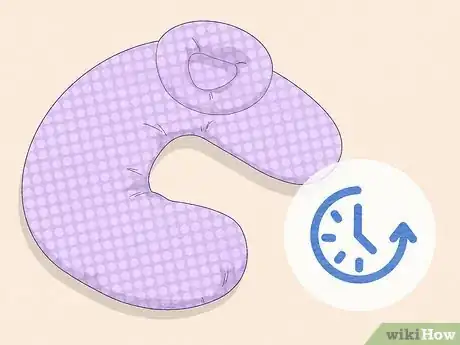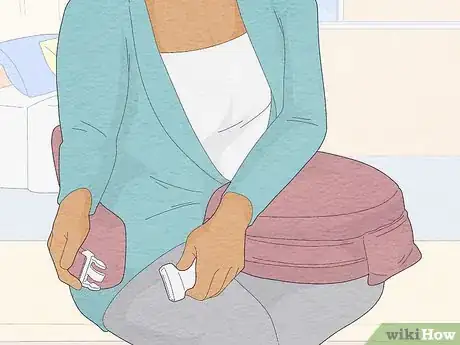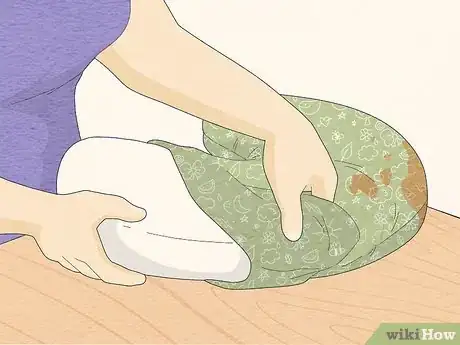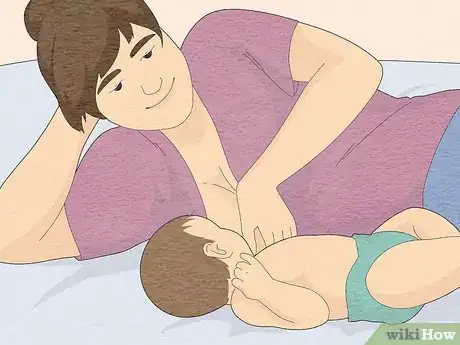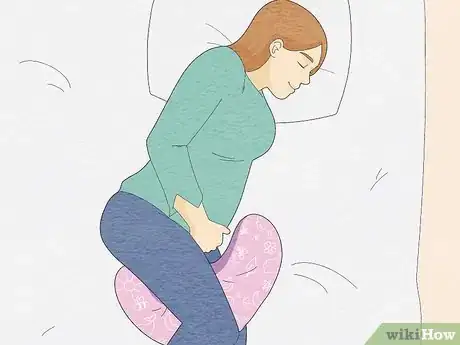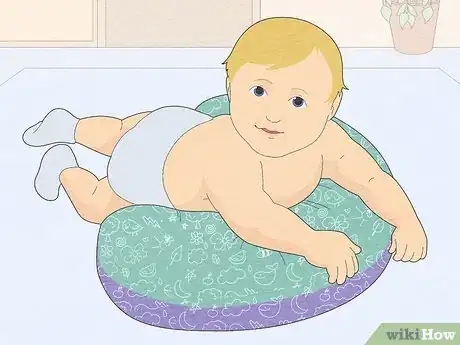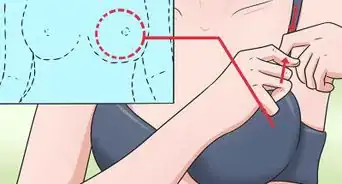This article was co-authored by Carrie Noriega, MD. Dr. Noriega is a Board Certified Obstetrician & Gynecologist and medical writer in Colorado. She specializes in women’s health, rheumatology, pulmonology, infectious disease, and gastroenterology. She received her MD from the Creighton School of Medicine in Omaha, Nebraska and completed her residency at the University of Missouri - Kansas City in 2005.
There are 11 references cited in this article, which can be found at the bottom of the page.
This article has been viewed 221,379 times.
A breastfeeding pillow is a pillow specially designed for the breastfeeding mother. Breastfeeding pillows come in a variety of styles and designs and are made to help you support your baby in the proper position for breastfeeding. Learn how to use a breastfeeding pillow to ensure your baby is in the proper position and to ease strain on your spine.
Steps
Selecting a Breastfeeding Pillow
-
1Consider how long you're going to be nursing. A breastfeeding pillow is a somewhat long-term investment. If you enjoy using it, and it works well for you and your baby, you will be using the pillow until you're finished breastfeeding. Keep this in mind when selecting your pillow.
- Some mothers only breastfeed for 3 or 4 months. In this case, you may not need to worry about the length and size of the pillow. A baby in that age range should fit on most breastfeeding pillows without much trouble.
- Some women choose to breastfeed longer. If you intend to breastfeed your child for a couple of years rather than a couple of months, go with a larger-sized pillow that can support a bigger child. However, as a baby gets older he'll be able to hold his head up and control motor functions more easily. [1] A pillow might not be necessary for support as you get past a year old.
-
2Look into fit and shape. Your baby is not the only factor when selecting a breastfeeding pillow. You also need to keep in mind your own size and shape to make sure the breastfeeding pillow fits your body.
- Many breastfeeding pillows are designed to strap around your torso so the pillow can support the baby's head and neck when you breastfeed.[2] Try to select a pillow that will fit your midsection shortly after birth. It's helpful to imagine yourself 5 to 6 months pregnant, as this is a good gauge of the size you'll need.
- Breastfeeding pillows come in different shapes: "c" shape, "o" shape, and the crescent shape. The "c" shape tends to be the most universal shape and generally fits the most body types while providing adequate arm support.
- O-shaped pillows wrap around the entire body, which can be good if your need extra support after pregnancy due to complications or a c-section.
- Crescent shapes are designed to wrap around the side of your body. They might not work as well for smaller women as the sides might fall on the back of the chair, sofa, or wherever you're sitting. Some crescent-shaped pillows, however, are adjustable and can be maneuvered to fit multiple sizes.
Advertisement -
3Decide whether or not you want fastening straps. Fastening straps are a popular addition to breastfeeding pillows. They are buckled straps that allow the pillow to fit closest around your body.
- The main pro of fastening straps is that they keep the pillow more secure. This makes breastfeeding less disruptive. You can also use the straps to pull the baby closer to your body.
- The biggest drawback of fastening straps is the difficulty of getting them on and off. Breastfeeding is unpredictable. Your baby could have issues, such as spitting up. Other children or pets could need attention, resulting in you needing to walk away from breastfeeding for a moment. The presence of straps could delay your response time to any issues that occur.
-
4Make sure it's easy to clean. Breastfeeding pillows get dirty easily. Babies spit up or have other accidents that causes debris to gather. Find a pillow that's easy to clean.
- The easiest breastfeeding pillows to clean have covers that can be removed and then machine washed and dried.
- Some breastfeeding pillows come with foam inserts that can be hand washed and then laid out to dry.
- Materials used also play a factor in the ease of cleaning your pillow. Sometimes, organic materials can be harder to clean. However, if you feel more comfortable with pesticide-free padding and fabrics know you might have to take time to hand wash your pillow.
Feeding with a Breast Feeding Pillow
-
1Decide how you'll sit while feeding your baby. How you use the pillow depends on how you position your body during breastfeeding. Choose a position that provides you and your child the most comfort.[3]
- Some women choose to breastfeed while lying back, or on their side, which is a popular position for breastfeeding. You can cuddle the baby by laying him across your chest or stomach to feed him, or have him lay right next to you on a bed or sofa. A breastfeeding pillow might not be necessary if you use one of these positions.
- If you breastfeed while sitting on a chair or sofa, with the baby lying across your lap, the breastfeeding pillow is particularly useful. It can support the baby's head and neck while you breastfeed.
- Many women tuck the baby under their underarm for support and breastfeed from the side. Some kind of pillow is usually necessary in such cases. A breastfeeding pillow, especially a crescent-shaped pillow, can help with such feedings.
-
2Use a breastfeeding pillow while breastfeeding.[4] When you sit down to breastfeed, regardless of the position and pillow type you chose, make sure you breastfeed with you and your baby's safety in mind.
- Place the breastfeeding pillow along the arm, lap, or side of your body where the baby will be seated during feeding.
- Gently, take your baby and place his feet under your arm, facing your back. Position him so his tummy is facing your body.
- Ease your baby down onto the breastfeeding pillow. The pillow will do some work for you in regards to supporting your baby.
- Make sure your baby is positioned on his side with his tummy facing you. Improper positioning could lead to gastric reflux or difficulty swallowing.
-
3Try using the pillow for bottle feeding. If you're weaning your baby, or your partner also feeds the baby, you can also safely use the breastfeeding pillow when bottle feeding.
- Find a comfortable place to sit and position the pillow on your lap or side. Lie with whichever arm you're using to support the baby's head on the pillow.
- When bottle feeding, your baby should be lying on a slight incline. His head should be tilted upward slightly.
- While you'll need to use your arm to keep the baby from wriggling too much, the pillow will still provide some support and take some of your baby's weight off of you.
Finding Other Uses
-
1Use a breastfeeding pillow during pregnancy. If you purchase a breastfeeding pillow before your baby arrives you can use it to provide relief from pains and discomforts during pregnancy.
- Tucking the breastfeeding pillow between bent knees during sleep offers lower back support. You can also tuck the pillow behind your back to help you stay on your side while sleeping.
- If you have pregnancy related heartburn, you can use an extra pillow to raise your head while sleeping.
-
2Add a breastfeeding pillow to tummy time.[5] Tummy time is a routine in which a baby is placed on his tummy for a little bit each day. The purpose of tummy time is to strengthen a baby's neck muscles and teach him how to push, roll over, crawl, and stand.[6] Breastfeeding pillows can be used to enhance tummy time.
- Most baby's sleep on their backs, in accordance to standards laid out by the American Academy of Pediatricians in 1992. This is to prevent sudden infant death syndrome.[7] As babies spend so much time on their backs rather than their stomachs, tummy time can be stressful.[8] Babies might resist being forced on their stomach.
- A breastfeeding pillow can help ease your baby into tummy time. Propping a baby up on a pillow can give him a new perspective and allow him to see more of a room. This can distract him from the discomfort of being on his belly, and prevent crying and distress during tummy time.[9]
- Make sure you don't prop your baby up using a breastfeeding pillow before 3 or 4 months, as his neck muscles might not be strong enough for this to be safe until then.[10]
-
3Understand the pillow is not for everyone.[11] Breastfeeding pillows can be a great tool, but they do not work for every mother.
- Sometimes, a breastfeeding pillow can result in your baby having difficulty latching. Some babies do not take to breastfeeding and prefer to be held, resulting in them becoming fussy or difficult to nurse when using the pillow.
- Nursing pillows are bulky and can be difficult to take from place to place. Some others also report having to lean over the pillows and experiencing back aches because of this.
- Remember, a nursing pillow is designed to provide you added comfort. Some women find the pillow to be helpful to them and their babies, but if a breastfeeding pillow causes you discomfort it's not a necessity. Old fashioned breastfeeding is fine if you don't feel comfortable with a breastfeeding pillow.
Warnings
- Do not leave a baby unsupervised on a nursing pillow.⧼thumbs_response⧽
References
- ↑ https://medlineplus.gov/ency/article/002004.htm
- ↑ https://www.webmd.com/women/psoriasis-new-mom
- ↑ http://www.nct.org.uk/parenting/breastfeeding-positions
- ↑ https://www.youtube.com/watch?v=J7eUwsH-Vns
- ↑ https://www.youtube.com/watch?v=A49xH_9x5ts
- ↑ https://www.mayoclinic.org/healthy-lifestyle/infant-and-toddler-health/expert-answers/tummy-time/faq-20057755
- ↑ https://kidshealth.org/en/parents/sids.html
- ↑ https://www.whattoexpect.com/first-year/week-13/tummy-time.aspx
- ↑ https://www.todaysparent.com/baby/baby-development/how-to-do-tummy-time-with-your-baby-8-fun-activities-to-try/
About This Article
A breastfeeding pillow is specially designed to support your baby in the right position while feeding. It’s particularly useful if you breastfeed while sitting with your baby lying across your lap, since it can support your baby’s neck and head. Just place the pillow wherever your baby will be lying, like your arm or lap, then lower your baby onto it. You’ll still need to keep your baby in place with your arm, but the pillow will help to take some of the pressure off your arm. It’s also useful for bottle feeding while sitting down. When bottle feeding, make sure your baby’s lying on a slight incline with their head tilted slightly upwards. For more tips from our Maternal co-author, including how to make use of a breastfeeding pillow while you’re pregnant, read on!
